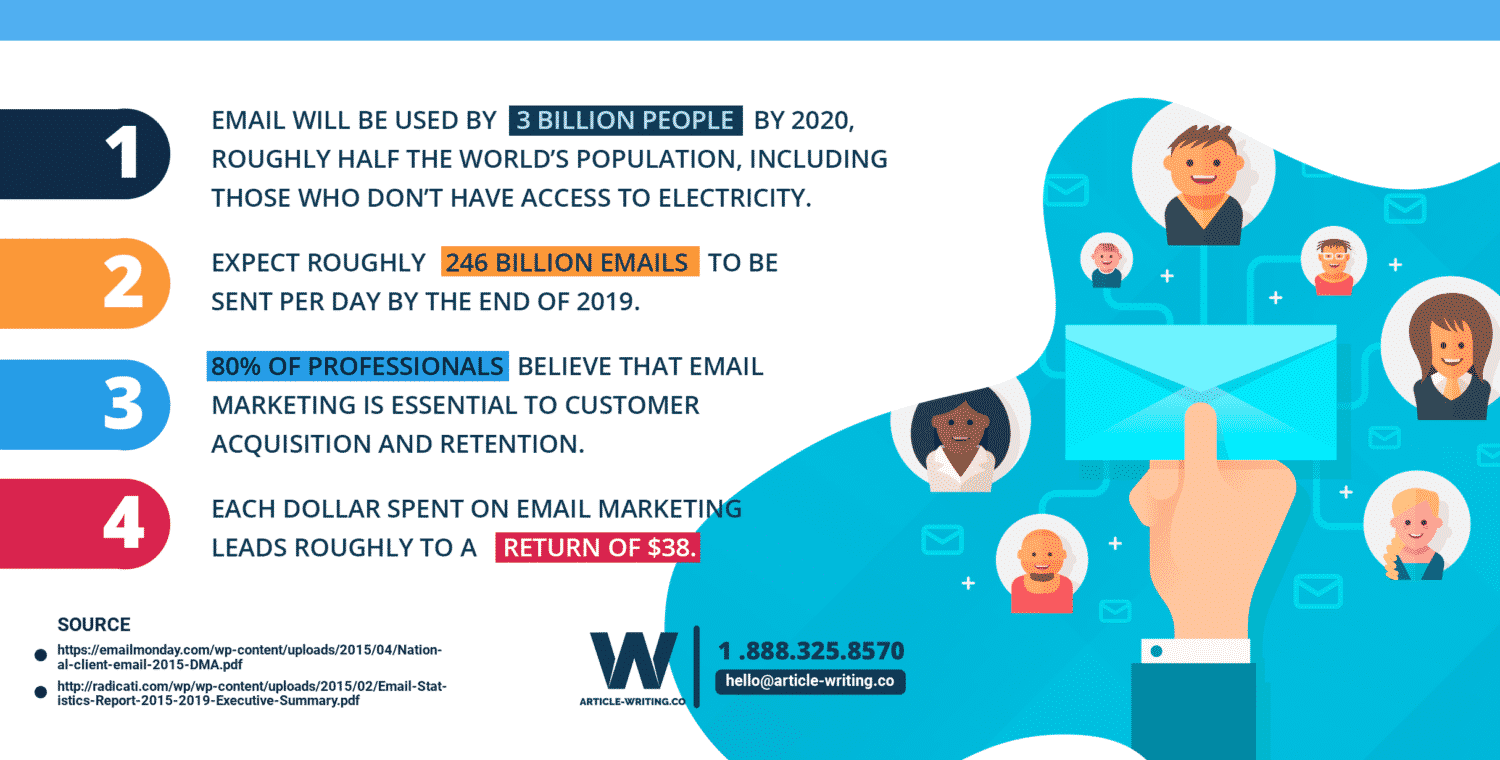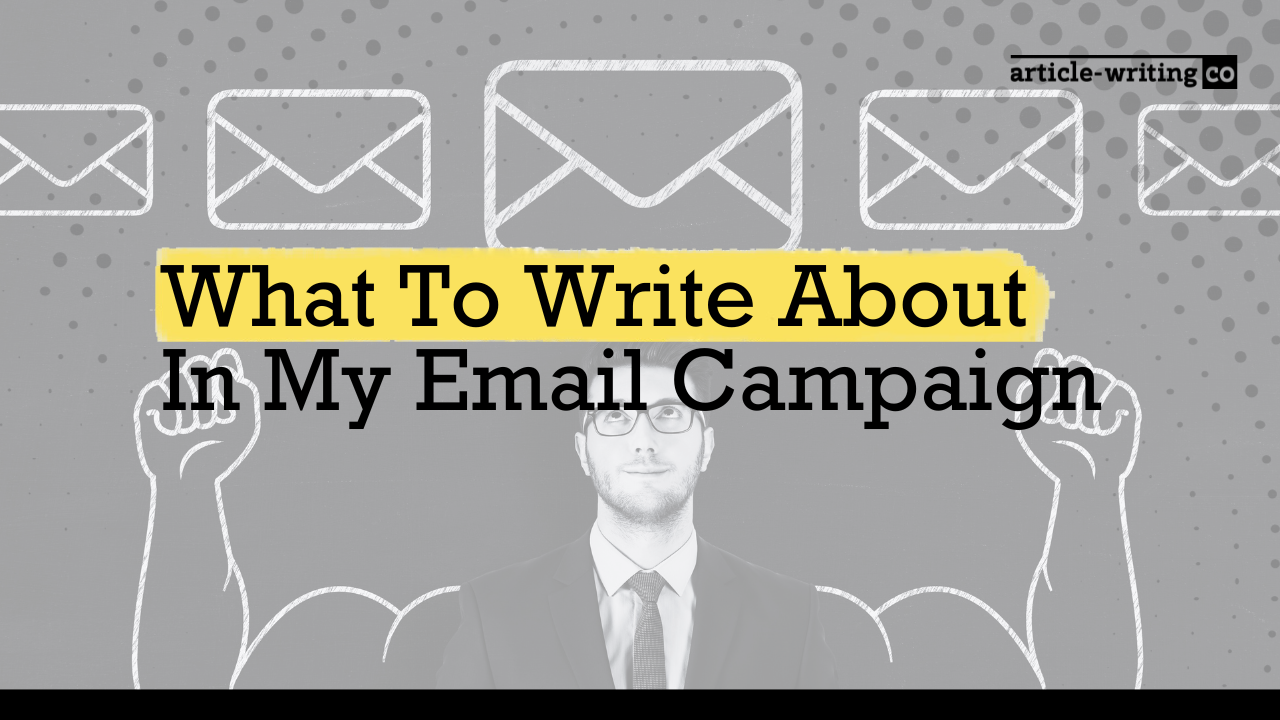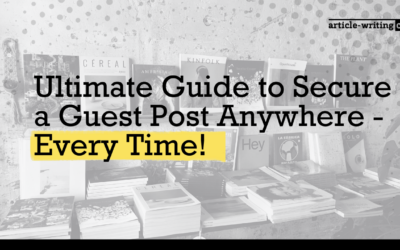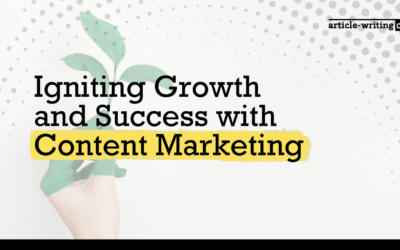
How To Figure Out What To What To Write About In My Email Campaign
To answer that question, let’s ask another one. What’s the goal of an effective email newsletter? The immediate goal is to communicate news and other things going on with your business to your audience of customers. This is why so many companies ask for your email with purchases or other offers, in order to have a future way to reach you. Along with what to write about in my email campaign, you may want to ponder ways to get that added value.
But like many marketing plans, there is the goal beyond the goal. Are you including a link in your newsletter to a potential sales funnel? Are you relaying information that will make your reader more likely to make a purchase? Are you trying to disseminate important information that will make them see you as an authority in your field? Having a clear plan in mind is key to email marketing success.
It’s also important to mention that a large-scale email newsletter isn’t the only form of email marketing out there. There are also many smaller pieces of email copy that are sent out to email lists regarding important PR news or more time-sensitive information. When done properly, these two concepts should work in harmony to provide a series of relevant information to the right people.

The Process Of Creating An Email Marketing Strategy
At this point, you may notice we’re working backwards, talking about the result of your email marketing campaign before figuring out what to write about in my email campaign. That’s because this is the first step in creating an email marketing strategy.
- Define Your Goals For The Campaign
Even if you already have a plan in place, you want to reevaluate your plan based on metrics from the past year. Are you not getting the number of email openings you want? Maybe people are opening the email, but they aren’t doing the follow-up actions you were hoping for. Think of it this way—running as fast or as hard as you can in a race doesn’t mean much if it’s in the wrong direction.
2. Define Your Audience
Chances are you may have a vague idea on what type of customers you want to serve, but in many cases, it’s the details you need to hook into in order to come up with a proper marketing strategy. If you don’t have these figured out, take a look at this exercise on buyer personas and try to put one together for yourself. Used by major companies worldwide, buyer personas are profiles of “ideal” customers for a business, and can help plug in the holes of any marketing strategy. All this factors into deciding what to write about in my email campaign.
One unique way that knowing your audience helps you in terms of creating an email marketing plan is determining what type of frequency is best. For example, if you’re targeting a high-powered audience of CEOs and other executives, you need to realize that your emails are competing with a swath of other communications. As a result, they have little patience for daily updates they haven’t requested themselves.
You may want to send fewer emails, but with greater informational value, so they save it for a later time to read at their leisure. However, if you’re targeting, say, stay-at-home mothers, reading news may be a part of their daily routine. As a result, they may be more willing to open newsletters, especially if you sweeten the pot with a relevant offer. In some cases, this may guide your hand on how to come up with topics for my company newsletter as well.
Another potential example is people in tech or engineering. Studies show that this industry has one of the highest click-through rates overall, largely because changes can occur so quickly. Here, your concern is less finding that sweet spot of frequency, and more making sure your finger is on the pulse.
3. Figure Out How To Build An Email List
One major area where companies fail in email marketing is thinking that the initial “push” for emails is enough. You may get started, put out some e-books or other offers to try and build an email list, then let it rest because you are focusing on other things. This is a huge mistake.
On average, your email marketing list decays by roughly 22.5% each year. This can happen in a number of different ways. The obvious ones are those who choose to opt out of communications, but there’s also those who switch email addresses or abandon “burner” accounts. In the B2B world, people are also constantly switching companies.
As a result, you need to constantly have new ways to improve your email list, ideally with people who fall under the buyer persona you created from Step 2. Here are some methods to get you going
4. Formulate A Content Marketing Strategy
At this point, you need to decide what the purpose of your email campaign is going to be. Are you going to cover relevant industry topics to position yourself as an authority in your niche? Certainly, this is nothing new, explains Adam Witty, CEO of Advantage|ForbesBooks.
“Although what’s called ‘authority marketing’ isn’t used as much as it should be, it’s not new,” Witty says. “More than a century ago, P.T. Barnum understood how to generate buzz around his name and get the press to report on his every move, which led to more ticket sales for his circus.” Many people may see books or social media as the best way to make this happen for your business, but email is just as effective.
There are a lot of different ways to approach the question of “what to write about in my email campaign.” Maybe you’re more interested in trying to communicate various offers and reasons why clients should utilize what you have to offer. Ideally, you’ll have some sort of data or idea of what your customer bases wants in order to guide your hand. If not, it may be worth it to try to look for potential feedback or encourage some yourself via surveys.
Remember, you may not get a direct answer, but you can read between the lines. For example, people may not tell an automotive repair business that they want emails with maintenance tips. However, you may hear people wishing they knew more about warnings and signals their cars give them. This is where you find opportunity in your strategy. Take advantage and incorporate this when deciding what to write about in my email campaign.
5. Design An Email Schedule
At this point, we know what types of email you want to send as well as what your goals are. The next step is to decide how you’re going to roll things out. There are pluses and minuses to the common options here, so let’s go over them in detail:
Daily Emails: On paper, there’s no way to build a relationship faster than with a daily email campaign. This is especially valuable if you are trying to position yourself as an influencer or thought leader, as that daily contact and name recognition will help develop a loyal following, provided you put out proper content.
This is a bit of a balancing act, though. For every person who enjoys what you are providing, some may be turned off by the constant stream and unsubscribe. The key here is making sure you are targeting people who will enjoy daily emails, and know exactly what to write about in my email campaign
Weekly Emails: This seems like the happy medium between going monthly and daily, not hitting the risk of being too spammy while being regular enough that you don’t get lost in the shuffle. The main concern here is leveraging your resources appropriately. If you’re doing daily email, it’s generally because it’s important enough that you want to invest in that type of presence. However, weekly may mean that you still have many other concerns. Make sure you are able to put together proper content when you’re going this route.
Monthly Emails: If you’re in the field where you need to use more long-form content, this may be ideal. Formal newsletters and larger emails are generally sent monthly, especially if they are paired with added value like a discount or promotion code. The major issue here is that you only really get one chance each month to get a customer’s attention. Readers with busy inboxes are more likely to forget that they’re part of your email campaign, and may not even think to click in the first place.
Of course, there are other schedules you can put together, from bi-weekly to tri-monthly to whatever makes sense. Ultimately, you want to strike a balance between frequency and quality.
Where Am I Going Wrong With What To Write About In My Email Campaign?
Say that you followed this last section of the guide, put together an email rollout for a month or two, and aren’t seeing the results you were hoping for. It’s important to manage expectations, especially at the start of a campaign, but that doesn’t mean you shouldn’t be looking for ways to improve. Here are a few ways that many companies falter in their email marketing, even if they’re happy with what to write about in my email campaign.
Too Dull: Your average office worker gets around 200 emails a day. As a result, they’re basically waiting for any reason they can to try and lower how many of those they have to read. One of the biggest ways to get skipped over is by having a weak headline or text that is overly bland. You only get a few seconds to grab someone’s attention even after they click, after all.
Misfocused: Matthew Smith, creator of Really Good Emails, explains that “Emails should serve the customer not the product. Often times the marketing team, not the product team is in charge of the email flow and their directive is to grow. If you get myopic about that task you forget that the most solid growth comes through simple, repeatable, service that is so good it’s sharable.” When you’re debating how to come up with topics for my company newsletter, be sure to keep this mindset at the back of your head.
Many marketers, when tasked with what to write about for my email campaign, fall into the trap of saying why their product is good, without saying why it is good for the customer. This applies to email as well. Try not to bombard a customer with images and copy and go for less, while providing them some sort of informational value. Less is more is something that all email marketers should think about.
Call To Action Problems: The last thing you want is to have an engaged customer who reads a good marketing email then does nothing else. All emails should go towards another goal, and your call to action is where your email copy and your greater goal meet. Without one, you’ve essentially created good work for nothing.
Some people go too far in the other direction. Trying to avoid sending too many emails, they cram several CTAs in one email. All this does is garble your message. Make sure you have a link to your website as well, if it’s not already in your CTA.
Going Image-Only: Many people respond to multimedia, right? Not when it comes to email. Stats show that only 33% of email subscribers have images turned on by default. However, there are exceptions, like selling visual products like clothes.
Inconsistency: If you have a monthly or weekly email plan, you need to stick to it. If you go off course early on, potential readers may think you are disorganized and unsubscribe. If you build a following then stop, people think that there’s some sort of issue or your business may be in trouble. No one wants that stormcloud following their brand.
Formatting Errors: The last thing you want is an error showing up on your final product, especially if it exposes your use of a template or something similar. People on email lists already feel like they are more of a commodity than a valued customer, and showing your hand with mistakes like these only feeds their concerns.
Improving The Process
In some cases, it’s not just one of these issues, but several of them that come together to impact the quality of your email campaign. Along with deciding what to write about in my email campaign, here are some things you can focus on to deal with those issues.
Check, Check, Check, (then check again): You don’t have to be a professional writer to be throughout when it comes to looking for grammatical and formatting errors. If you’re having trouble, consider using programs like Grammarly or Hemingway to make this part easier.
Be Sure to Be Useful: At the front of your mind while drafting an email should be the customer’s needs. By taking their time to click and read, what value are they getting from you? This is the easiest way to make sure that you don’t lose their interest halfway through.
Write Scannable Copy: This basically means using every means at your disposal to make it easy for a reader to get the basic point quickly. Short paragraphs and heavy use of subheadings/headings are great. If you are trying to share a larger article, give a teaser and add a Read More link. Remember, you need to think from the customer’s perspective. You already know your article is great and informative, but you need to prove it to them.
Think About Shareability: Email and social media are different worlds, but both are made for sharing. If you are sharing a discount or a valuable piece of info, encourage your readers to spread the news with a “Forward to a friend” link. Social sharing functionality is important as well.
Choose The Right Headlines: Of course, none of these work if you don’t get a click to begin with. This is where headlines are extremely important. Putting an emphasis on actionable language, but the truth is that this may be a matter of trial and error. Ideally, you want something that ties into what to write about in my email campaign. Some email service providers use a split-testing functionality so you can compare the success of the same content, but with different headlines. If you’re struggling, we’ve compiled some tools that will help you make great headlines.
Hiring Email Writers
One thing you need to understand about writing email copy is that it’s very different than writing an email to your coworkers, family, or friends. In any of those cases, the recipient has an obvious motivation to click and some sort of relationship built up. With email marketing, you may need to start from zero, competing with potentially hundreds of other emails a day for that same click.
This means that every single word you choose needs to be carefully planned—something that’s difficult for those not from a writing background. Imagine putting forward this type of effort for a daily email? This is why it’s important to get adequate support for your email marketing campaign.
At some levels, you may be able to use automated tools to help make this job easier, but they only handle part of the issue. For example, if you run a daily or weekly email campaign, it’s a good idea to try and use trendy topics in your niche to grab attention. Rather than do an hour of research every morning, there are tools that will grab relevant stories and headlines and send them to you. There’s still the matter of writing the emails though, which may be time you don’t have as a business owner.
The time crunch isn’t the only reason that it’s worth investing in a professional writer for your email campaign. For one, written copy of any kind can be a double-edged sword. Done properly, it communicates certain brand attributes and relevant information to a targeted audience. But what happens if it’s done improperly?
Every typo, strange sentence, or slap-dash piece is a blaring signal to anyone that there’s something wrong with your business. Even if the customer can’t quantify it, bad copy makes them stay away. Even worse, they may relay it to people in their circle, meaning you’re losing customers you didn’t even get a chance to reach.
In addition, bringing on professional writing help means you can catch conceptual issues with your marketing strategy right away. Every good professional writer that works with a business will do their due research on the company itself and their target audience. This is essential in order to craft copy with an appropriate tone. However, what it also does is provide you with a different point of view, something that is invaluable in many cases. Overall, email marketing services save time and increase impact.
Finding Email Marketing Support
At this point, we’ve established the case for getting outside help for your email marketing, but what about figuring out how to get said support? Here are a few things to think about while outsourcing content creation.
Bring Somebody On: There are many writing professionals out there that could make great members of staff, but the fact of the matter is that taking on any kind of full-time employee is a major expense. While hiring email writers could also help you with other types of marketing materials as well as internal copy, many businesses just don’t have the bandwidth in order to justify such a long-term hire. In addition, if you need to get a project done right away, the hiring process may take too long for this to be a viable option.
Work With A Freelancer: Hiring freelance email writers is appealing for many reasons. The growing popularity of the “gig economy” and more platforms than ever that serve freelancers mean that you have a lot of options to choose from. Along with these, you can also look up local publications, colleges, and writing programs to find potential candidates.
The issue with bringing on a freelancer for your email marketing campaign is that in many ways, it’s a roll of the dice. There are several top names out there who make their money exclusively through freelancing, but these individuals:
A: May require negotiation to get an agreeable rate.
B: May be booked for the time being with other clients.
When it comes to how to find a newsletter writer, you may look for other tiers of freelancers. At this point, reliability is a major concern. Ideally, you want to work with a freelancer who has a portfolio of similar work for you to look at, as well as clauses in an agreement letter or contract regarding revisions, if necessary. Not everyone does this, though, and the last thing you want is to be behind on your campaign because your freelancer disappeared or dropped the job for whatever reason.
Choose an Agency: Agencies are a bit of the “happy medium” between the two options they mention. Some pull their writers from the freelance pool, but they are proven to be reliable and skilled, exactly the people you want working on your emails. In addition, working with a larger company rather than an individual generally means a more organized approach to your work.
Ultimately, investing in skilled email copywriters is more than just a case of passing the buck, but entrusting a cornerstone of your marketing success with those best prepared to handle it. At Article-Writing.co, our network of email copywriters can help you create copy that will have the widest amount of reach while still fitting the specific needs of your niche. And above all, we help refine your email campaign to create a final product your email subscribers will love.

David is the Founder and Director of article-writing.co, the fastest-growing content creation agency in North America. He has transformed companies by offering high-quality content that has impacted their SEO ranking, revitalized websites with engaging and industry-relevant blogs and website copy, and championed successful email campaign copy.




